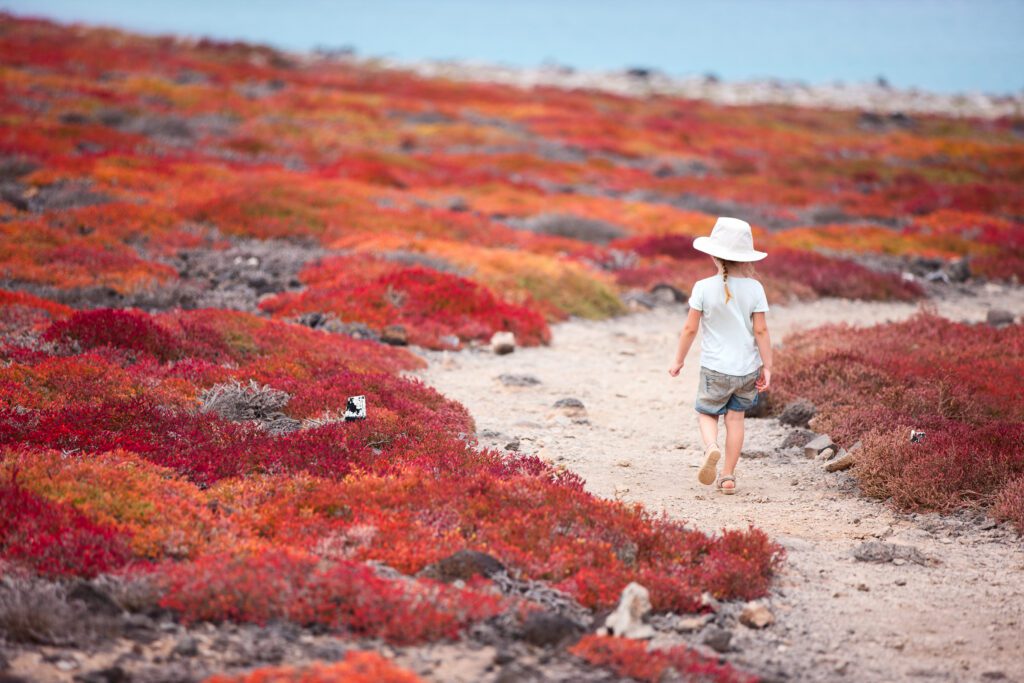The Galápagos Islands are renowned for their exceptional biodiversity, unique landscapes, and unparalleled wildlife experiences. However, planning a trip to the archipelago can be complex due to its remote location, diverse options, and specific travel requirements. Certain wildlife is found only in specific areas, and the landscapes vary widely across the islands, making it crucial to choose the right islands or cruise.
How to Get There
To reach the Galápagos Islands, you must first fly to Ecuador’s mainland (either Quito or Guayaquil). From there, you can take a direct flight to one of the two main airports in the Galápagos: Baltra Airport (near Santa Cruz Island) or San Cristóbal Airport (on San Cristóbal Island). Several airlines operate daily flights to the islands, and it’s recommended to book in advance due to limited capacity.
Best Time to Visit
The Galápagos is a year-round destination, but the best time to visit depends on what you want to see and experience. Very little of the wildlife here is migratory, meaning that you can generally see most animals here year-round. The weather is split into a wet season and a dry season, with temperatures fluctuating very little.
Wet Season: Typically, from December to May. During this period, temperatures are warmer, and there is more rainfall, although it often comes in short, brief showers. This season is also known for calmer seas and warmer waters, making it ideal for snorkeling.
Dry Season: Usually from June to November. The weather is cooler and drier, with occasional mist and fog. The seas are rougher, and the water temperatures drop slightly, but this period is great for hiking and land-based wildlife viewing.
While you can see wildlife all year, December is hatching season for the giant tortoises, and July is mating season for blue-footed boobies and short-eared owls. Sea turtles lay their eggs early in the year and fully formed marine iguanas typically hatch in April and May.


Choosing Islands to Visit& Wildlife You Can Expect
The Galápagos Islands are typically divided into four main regions based on their location within the archipelago: Eastern, Western, Central, and Northern islands. Each region has its unique features in terms of wildlife, landscapes, and activities. Here’s a breakdown with information to consider when deciding where to go and which cruise to choose:
1. Eastern Islands
These islands are more frequently visited and are located to the east of the archipelago, closer to the mainland Ecuador. The Eastern Islands are often known for their rich wildlife and historical significance.
- Key Islands:
- San Cristóbal (known for the interpretation center and the first island Darwin visited)
- Santa Cruz (home to the Charles Darwin Research Station and giant tortoises)
- Española (renowned for its birdlife, especially the albatross)
- Floreana (known for its human history and unique wildlife, like flamingos)
- Genovesa (a birdwatching haven with many seabirds, including the red-footed booby)
- Highlights: Ideal for birdwatching, historical sites, snorkeling, and a great variety of iconic Galápagos wildlife like sea lions, frigatebirds, and tortoises. Genovesa and Española are prime spots for birdwatchers. Giant tortoises can be found on Santa Cruz and San Cristóbal.
2. Western Islands
The Western Islands are known for their dramatic volcanic landscapes and are less visited than the Eastern Islands. They are famous for marine life and more remote, rugged terrain.
- Key Islands:
- Isabela (the largest island, home to the famous Sierra Negra Volcano and giant tortoises)
- Fernandina (known for its volcanic activity and unique species like marine iguanas)
- Santa Fé (offers excellent snorkeling and a chance to see rare species like the land iguana)
- Highlights: Best for marine life encounters (whale sharks, hammerhead sharks), volcanic landscapes, and diving. Offers more isolated experiences for adventure seekers and nature lovers. The only species of penguin found near the equator, the Galápagos penguin, can be seen on Isabela and Fernandina. Giant tortoises can be found on Isabela.
3. Central Islands
The Central Islands serve as the gateway for most visitors. They include islands that are closer to the mainland and often feature more developed infrastructure for tourists.
- Key Islands:
- Santa Cruz (where most visitors land, known for its urban center in Puerto Ayora and the Charles Darwin Research Station)
- Santiago (known for its volcanic landscapes and a great place to spot marine life)
- Highlights: These islands are often where tourists start and end their journey. Santa Cruz is especially famous for its tortoise breeding program, and the region offers easy access to many other islands.
4. Northern Islands
The Northern Islands are generally more remote, and they’re often chosen for specialized activities like diving and birdwatching. These islands are less frequented by tourists, making them perfect for those looking for a more isolated experience.
- Key Islands:
- Wolf (famous for world-class diving with hammerhead sharks)
- Darwin (known for its pristine marine life and as a site for advanced divers)
- Highlights: Ideal for diving enthusiasts, these islands offer unique experiences like schools of hammerhead sharks and the opportunity to see rare marine species. They’re not typically visited on regular cruises due to their remoteness, but they are included in specialized expeditions.
Summary:
The Eastern Islands are popular and accessible, known for birdwatching, historical sites, and diverse wildlife. The Western Islands offer rugged volcanic landscapes and are best for diving and marine life encounters. The Central Islands serve as the tourist hub, with key research stations and easy access to other islands. The Northern Islands are remote, ideal for advanced divers seeking pristine marine environments and rare species.
Deciding between a land-based trip or a cruise
Deciding between a land-based trip or a cruise depends on your preferences:
Cruises: are the most popular way to see the Galápagos, and they offer a variety of experiences. allowing you to visit multiple islands in a shorter time. Cruises often include guided tours to remote locations, perfect for those who want to explore more diverse landscapes and wildlife. It’s a great option for those seeking convenience and the opportunity to see a broader range of the archipelago.
Land-Based Travel: If you prefer staying on land, there are hotels and lodges on islands like Santa Cruz or San Cristóbal. This option gives you the freedom to explore at your own pace, but it requires more time and effort to visit multiple islands, as you’ll need to arrange day trips or boat rides.


Essential Galápagos Etiquette Tips to Remember
Respect Wildlife: Maintain a safe distance (at least 2 meters) from animals and never touch or feed them.
Stay on Marked Trails: Stick to designated paths to protect fragile ecosystems and avoid disturbing wildlife.
Don’t Litter: Carry all trash with you, as there are limited waste disposal facilities on the islands.
Limit Noise: Keep noise levels low to avoid disturbing animals, especially nesting birds.
No Souvenirs: Do not collect or remove any plants, shells, or rocks from the islands.
Respect Local Culture: Be mindful of local customs, especially in small villages, and ask before taking photos of people.
The Galápagos Islands have long held a mythical allure, standing as one of the world’s most extraordinary wildlife destinations. We understand that this is a once-in-a-lifetime journey, and we’re here to ensure it’s everything you dream of. Whether you’re planning a dedicated Galápagos adventure or incorporating a cruise into a grand round-the-world journey, we’re here to make your dream trip a reality.


